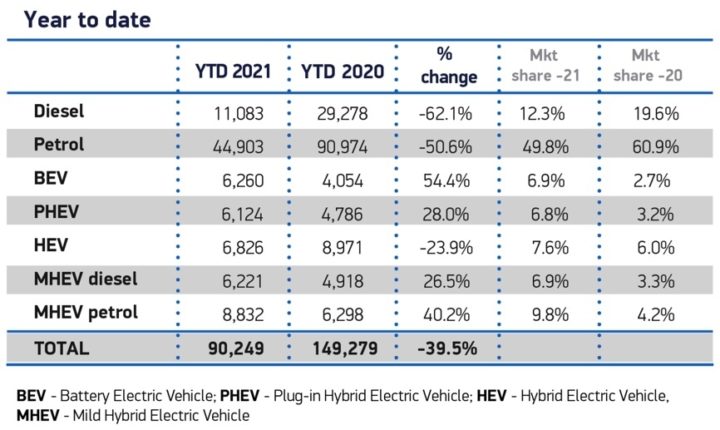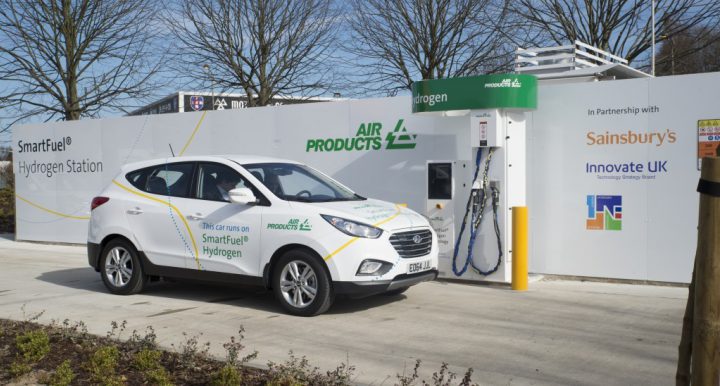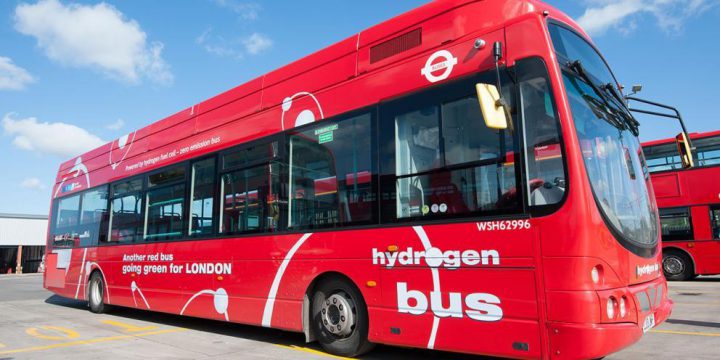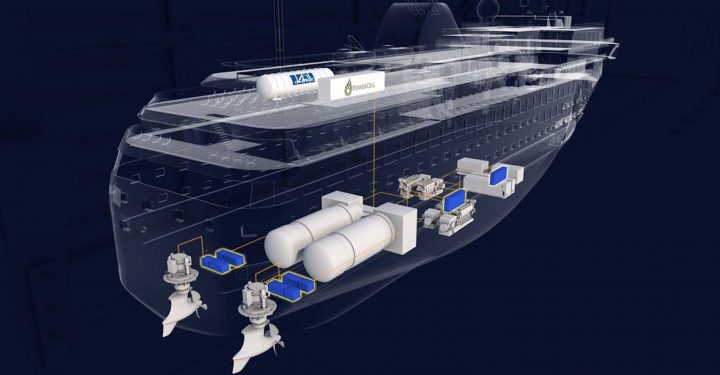Hydrogen for transport
How could hydrogen be used for net zero transport?

By Jess Ralston
@jessralston2Share
Last updated:
Different modes of transport are suitable to different means of decarbonisation. In 2018, the Committee on Climate Change (CCC) stated that ‘while battery electric vehicles are now well placed to deliver the bulk of decarbonisation for cars and vans, hydrogen fuel cell vehicles could play an important role for heavy-duty vehicles (e.g. buses, trains and lorries) and potentially for longer-range journeys in lighter vehicles’.
There is already evidence that electrification, a readily available technology, is becoming the chief technology for decarbonising lighter vehicles. There are now just under 350,000 electric cars and vans on UK roads, compared to just 218 alternative fuel vehicles, which includes hydrogen. In 2020, sales of battery electric and petrol-electric hybrids rose by 54% and 40%, respectively.
This is mirrored in manufacturer pledges; Jaguar Land Rover and Bentley Motors have both vowed to have a fully electric fleet by 2025 and 2030 respectively.

Heavier transport – lorries and buses – is more suited to hydrogen as electrification would require very large batteries, leading to both cost and weight implications.
How does hydrogen power a vehicle?
Hydrogen is used to power fuel cells. The most common type of fuel cells in vehicles is the polymer electrolyte membrane (PEM) fuel cell.
Within the fuel cell, a thin surface called a membrane is used to separate oxygen and hydrogen. The oxygen is collected by a positively charged conductor (a cathode) and hydrogen at a negatively charged electrode (an anode).
An electrochemical reaction in the fuel cell then breaks the hydrogen molecules into protons and electrons, which are positively and negatively charged respectively. Once separated from the electrons, protons travel through the membrane to the cathode and the electrons travel through an external circuit, providing power to the battery and propelling the vehicle.
The electrons eventually recombine with the protons and oxygen molecules at the cathode to form water that is emitted from the exhaust, the only by-product. The whole process is analogous to that in a rechargeable battery.
Hydrogen is stored in a tank, similar to petrol or diesel. It is compressed to compensate for low energy density and can be refuelled in a very similar process to existing petrol and diesel cars.
What types of transport can hydrogen fuel cells be used for?
Road transport - cars, taxis, vans and HGVs
A small number of hydrogen cars and vans are for sale today. Toyota released the Mirai model in 2015 and have plans for another, for example.
Supporters of hydrogen vehicles suggest that they do not suffer from ‘range anxiety’ due to the ease of refuelling. Rapid advancement in the capacity of electric vehicle batteries undermines this argument.
In addition, hydrogen fuel cells are much more efficient than a typical petrol or diesel engine at 60% efficiency versus 25%. However, pure electric vehicles are more efficient than both, at more than 80%, and some now have ranges of up to 350 miles.
At the moment, there are 16 hydrogen refuelling stations in the UK compared to over 27,000 fast, rapid and ultra-rapid chargers. Most hydrogen refuelling stations are in South East England, but there are more in the pipeline in the North and Midlands, close to hydrogen supply clusters – although they will need to be distributed evenly across the country if hydrogen vehicles are to become widespread.

HGVs are much less suited to electrification because heavy loads over long distances would require very large batteries. For example, batteries could weigh as much as 15 tons for the all-electric Tesla Semi lorry (500 mile capacity) model compared to less than 550kgs for their passenger vehicle. Larger batteries are at the moment quite expensive, which means hydrogen may be a more cost-effective solution.
Hyundai are also working on HGVs and in summer 2020, it shipped ten of the world’s first hydrogen powered lorries to Europe. They aim to produce 1,600 globally by 2025. However, these lorries are thought to be operating shorter maximum mileages of 248 miles compared to Tesla’s 300 and 500-mile models.
The National Infrastructure Commission has recommended to Government that diesel powered HGVs should be phased out by 2040 and there is a consultation expected soon on the phase out of fossil fuel HGVs which should give an indication of the future direction for these types of vehicles.
Buses and trains
Buses and rail each account for less than 5% of UK transport emissions. Like lorries, buses have a heavier load and can travel long distances in a day. Developers are focussing on fuel cell electric buses, that store 30-50kgs of compressed hydrogen on board. Ranges can be as high as 185 – 280 miles, comparable to diesel buses.
Fleets of hydrogen buses already being deployed in London and Aberdeen could be expanded relatively quickly. In London, there are four refuelling stations spread across the Capital and more than 20 hydrogen buses in circulation.
In 2021, the Government launched the ‘Bus Back Better’ strategy, which commits to 4,000 new zero emissions buses, which is more than a tenth of the fleet, backed by £120m and a place-based approach to infrastructure and vehicles. Coinciding with this, a consultation on the end of new diesel bus sales has been published to ‘drive forward the decarbonisation of public transport’. In addition, the London Mayor has set a target for all 9,200 buses across London to be zero emissions by 2037, to include electric and hydrogen buses.

Hydrogen trains use hydrogen battery engines, where hydrogen and oxygen are used to produce electricity to charge the train’s battery. Tanks for the gases and the fuel cells sit underneath the trailer cars of the train and give a range of around 650 miles.
The hydroFELX hydrogen train was launched in September 2020 following £750,000 of Government support. By 2023, it is expected that the technology could be retrofitted into trains currently in use. However, there is also a programme to electrify the remaining 58% of the UK’s tracks, so that fully electric models could be used instead. Not all tracks could be electrified though, such as those that go through tight tunnels with no space for overhead lines, so hydrogen trains are likely to be needed regardless.
Shipping and aviation
Shipping accounts for 3% of the UK’s emissions and 2% of global CO2 emissions. The International Maritime Organisation has committed to reduce emissions by at least 50% by 2050, compared to 2008 levels; the Climate Change Committee has indicated that both hydrogen (for short journeys) and ammonia (a compound of hydrogen and nitrogen which is more easily stored for long journeys) will be used to save the majority (87%) of emissions from shipping.

Despite the first hydrogen carrier ship being launched from Japan in 2019, the hydrogen was generated from coal in Australia so the ship was not fully clean of emissions. Closer to home, Scotland is undergoing trials for the world’s first hydrogen powered ferry.
In addition to shipping, hydrogen could be valuable as a fuel in aviation, the most carbon-intensive form of travel and responsible for 7% of the UK’s emissions.
In 2020, the Prime Minister launched the ‘Jet Zero Council’ to bring together industry and Government to accelerate the decarbonisation of aviation. Although the future is very uncertain, the CCC suggest that biofuels and a synthetic jet fuel made using hydrogen could make up 25% of fuel consumed in 2050. However, these fuels and electrification are likely to only be used for short-haul flights and efficiency improvements, demand reduction and greenhouse gas removals form the bulk of emissions reductions.
In the industry, Airbus has recently unveiled the ZEROe - ‘three concepts for the world’s first zero-emission commercial aircraft which could enter service by 2035’, and which all rely on hydrogen as the fuel source.
How does the UK compare to investment abroad?
The UK is set to publish a hydrogen strategy in 2021, which is expected to give an indication of the role that hydrogen will play in transport (and beyond). However, other countries have already set out how they plan to use hydrogen in transport.
South Korea and Japan are equally as invested in developing hydrogen for transport. With car manufacturers Hyundai (S. Korea based) and Toyota (Japanese) leading the way for car models so far, their respective Governments have taken a similar stance.
In South Korea, the Hydrogen Economy Roadmap outlines a goal to produce 6.2 million fuel cell electric vehicles, at least 1,200 refilling stations and 41,000 hydrogen buses by 2040. Comparably in Japan, the Fukushima Hydrogen Energy Research Field completed in March 2020. Every day, the plant is able to supply 150 households with power for a month or fill 560 fuel cell vehicles.
For hydrogen to be fully ‘green’, the emissions generated would have to be captured and stored or used, which is currently quite expensive. Although questions remain, technological advancements might help with this and bring costs down in the longer term.
Share